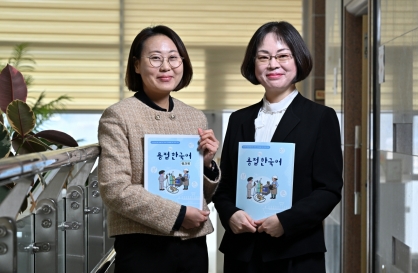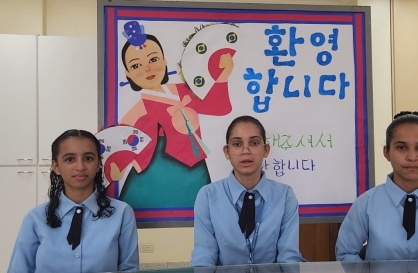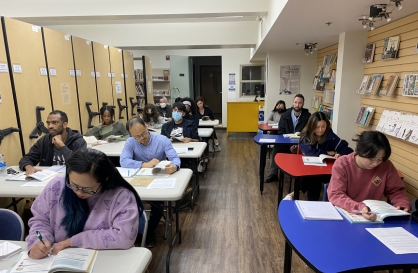Most Popular
Hello Hangeul
-
1
Welding book first in vocational Korean series for foreign labor

-
2
[Korea Beyond Korea] In Sao Paulo, horizons expand for Korean studies
![[Korea Beyond Korea] In Sao Paulo, horizons expand for Korean studies](//res.heraldm.com/phpwas/restmb_idxmake.php?idx=644&simg=/content/image/2023/11/20/20231120000619_0.jpg&u=20231206104853)
-
3
In Brasilia, worldly dreams are born from Korean classes

-
4
Americans seeking to visit Korea learn the language in LA

-
5
[Korea Beyond Korea] Berlin, Europe's Korean Studies hub, nurtures next-gen experts, scholars
![[Korea Beyond Korea] Berlin, Europe's Korean Studies hub, nurtures next-gen experts, scholars](//res.heraldm.com/phpwas/restmb_idxmake.php?idx=644&simg=/content/image/2023/10/18/20231018000929_0.jpg&u=20231023154735)
[Hello Hangeul] The making of Korean language textbooks featuring BTS
S. Korea's Education Ministry takes lead in overall Hangeul textbook development, but more efforts needed, experts say
By Park Jun-heePublished : Sept. 24, 2023 - 15:27

In response to the growing international demand for learning the Korean language, the South Korean Education Ministry took a proactive step in 2021 by creating a government-managed Korean language education curriculum.
Prior to the central government's involvement, the selection and distribution of language courses and textbooks were primarily handled by local Korean language education centers. This led to concerns about the lack of structured content that could cater to the diverse language proficiency levels and ages of foreign learners.
The government’s initiative launched two years ago has attempted to encompass the development of textbooks and supplementary educational materials so far.
Distributed to students and teachers at elementary and high schools worldwide that have adopted Korean language as an official subject, all textbooks are provided free of charge.
A total of 201,788 textbooks have been distributed to 28 countries as of 2022, according to the ministry’s overseas education support division.
The type and number of textbooks are issued annually in September -- since many schools start their academic year that month -- after carrying out a demand survey, the ministry explained, adding that about 7.2 billion won ($5.4 million) had been spent each year since 2021.

The textbooks are made based on the Common European Framework of Reference for Languages (CEFR) -- an international standard that describes language ability on a six-point scale, from A1 for beginners, up to C2 for those who have mastered a language.
Currently, the Korean language textbook levels are divided into eight groups -- Pre-A1, A1, A2 and A2+ for beginner levels and B1, B1+, B2 and B2+ for intermediate levels, which consist of textbooks, workbook materials and a teacher’s guidebook.
Also in 2021, the ministry teamed up with Hybe Edu, the education technology division of Hybe, the K-pop agency that houses BTS, to develop supplementary learning material for Korean classes at local schools that can help students delve into the Korean culture and its language more effectively.
The Korean-language textbook package featuring BTS is mostly video-based and contains practical phrases and expressions that are useful in everyday situations. Apart from the BTS content, the supplementary materials also cover Korea’s history, culture and society.
The ministry has also teamed up with education authorities, teachers and language education specialists both at home and abroad to curate tailor-made Korean-language textbooks that better address the needs of the targeted learners and cater to the needs of learners at different proficiency levels. Among those countries are Laos, Malaysia, Mongolia, Vietnam, Brazil, Uzbekistan, Thailand and the Philippines.
Linguistic experts, however, pointed out more efforts are needed to enhance the quality of Korean language education worldwide.
Yun Suk-jin, a Korean language professor at Chungnam National University, noted that bilingual textbooks are needed for beginners and would help foreign learners overcome language-learning barriers.
“(Using) the local language (in learning a foreign language) is necessary, especially for beginners when it comes to learning a language because their mother tongue would help them better grasp the nuances (of the Korean language) in the initial phase and use (their native language) as a reference to understand (Korean),” Yun said.
Prof. Lee Eun-jeung of the Free University of Berlin, meanwhile emphasized the necessity of textbooks on Korean grammar, stressing the need for advanced-level Korean language education. Additionally, materials that enhance comprehension of idioms and words connected to Chinese characters are also needed.
“The teachers in our Korean studies department believe that our students most need textbooks for the advanced-level Korean language. We also need grammar textbooks,” she said.
“There’s also a lack of materials that can help learners understand idioms and Korean words based on hanja (Chinese letters), which is essential for learners to be able to dig deeper into the Korean culture and history.”
Korea's technological expertise, combined with the government's commitment to developing digital textbooks, has the potential to push up the education quality, experts said.
“There are so many parts of Korean language textbooks that have yet to be digitalized. Other language textbooks allow learners to download e-textbooks on Kindle and provide educational video clips online. But many Korean language textbooks are still offered in hard copy. We have a long way to go,” said Chi Seo-won, professor at the National University of Singapore.
This is part of The Korea Herald’s “Hello Hangeul” project which consists of interviews, in-depth analyses, videos and various other forms of content that shed light on the stories of people who are learning the Korean language and the correlation between Korea’s soft power and the rise of its language within the league of world languages. – Ed.












![[Korea Beyond Korea] In Sao Paulo, horizons expand for Korean studies](http://res.heraldm.com/phpwas/restmb_idxmake.php?idx=644&simg=/content/image/2023/11/20/20231120000619_0.jpg&u=20231206104853)


![[Korea Beyond Korea] Berlin, Europe's Korean Studies hub, nurtures next-gen experts, scholars](http://res.heraldm.com/phpwas/restmb_idxmake.php?idx=644&simg=/content/image/2023/10/18/20231018000929_0.jpg&u=20231023154735)






![[More than APT] Residents, architects together design homes](http://res.heraldm.com/phpwas/restmb_idxmake.php?idx=652&simg=/content/image/2024/11/24/20241124050036_0.jpg&u=)
